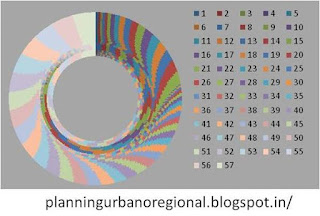Please visit my web page "Urban Tenets" at https://urbantenets.nl/
************************************************
(Reshared; original post 2012)
Oh, another bunch of refined paper goes to waste-bin thanks to extremely complex and varied document printing processes across the varied software environment, across the government, corporate and educational institutions, across the world. Taking heavier and heavier toll on environment with every “Ctrl+P+Enter”, possibly every second rather micro-second in some corner of world.
It’s fairly easy for a planner specially an architect planner to acknowledge this fact of unsustainable printing practice and track down the reasons behind that due to their diversified nature of work, active participation in software environment and multiplicity of technological affinity. An average planner with architectural background is usually familiar with at least 10 to 15 software even excluding downstream subsidiaries of parent software programs, comfortable working with 7 to 10 software and currently must be using 3 to 7 software applications spread across desktop to online to cloud based environment; Some frequently used software tools ranging from drafting to data gathering and aggregation, to data analysis and interpretation, to collaboration, to mapping and image interpretation to presentation and simulation and so on, printing system ranging from tiniest of printers to the largest of plotters available. And he or she can easily recognize that one thing common in all these tools, systems and activities, is that nothing is common when it comes to Ctrl+P, i.e. print command i.e. printing process. Hence the huge environmental losses!
It’s not that you must have a global authority to control printing behavior across this technological landscape, its more about morality of tech-producers, corporate management as well responsibility and choices at user’s end. Still, it won’t be a bad idea to have some form of global printing governance and management through a nodal or distributed agencies across the globe just to identify, evolve and clinically establish the best probable practices in printing, standardizing and implementing the best printing practices and related programming practices through integration at software programming stage itself or to introduce plugins at regular intervals as tech-retrofit or to printducate (education of best practices about printing) while kids are still getting educated or even through organizational incentives if needed. Some examples of technological intervention even if you consider these at lighter note can be like default “Always draft mode otherwise specified” setting across the printer and plotter community and product lines across the world no matter small or large, something like having two big display/ push buttons one green and one stark red which will appear the moment you press the Ctrl+P (print command), green bottom (default draft mode) saying something like- “Thanks for choosing me because you are helping mother nature to thrive, btw do you really need to do even this?” and the red button (customizable for higher resolutions) saying “think twice before going ahead with higher-resolution, with this single click you might add little more burden to our mother nature, can’t you think of some other way to communicate to help save little more of ink cartridge and little more of paper?”
One interesting and probably right observation and recommendation is that we might need to revise the definition and perception of Draft Print Resolution. At present drat image or text resolution is kind of too much pixelated draft, and creates vast disparity in the outcome of high-resolution (even normal-resolution) and draft-resolution print, hence more and more people are opting for either high or normal resolution across the organizations, leaving draft unattended. We need to raise the print resolution of default draft resolution little higher than the present configuration so that people do not immediately make higher resolution print choices discarding the draft. There is one dilemma here as well, a common educated person, environmentally conscious as he or she thinks of himself or herself, making more damage to environment than the average person with stubborn but consistent printing behavior. Most of the environmentally conscious persons take draft mode printouts as a natural choice to protect the environment only to realize that printouts are too hazy, unclear, un-presentable to the client or audience and they end up taking same print again in normal or higher resolution format (shear wastage point No. 1, in the name of being environmentalist), they also tend to take higher size/ A3 content on an lower size/A4 paper in their deliberate (sometimes showing-off) effort to save paper/ environment, only to realize that the texts printed are almost unreadable or at least not presentable and hence they end up taking printouts again on larger size paper (shear wastage point No. 2, in the name of being pro-green or something), same story in case of slide Vs handouts as well. All of this wastage can be avoided just by keeping print command in universally default draft mode while making draft mode with little better resolution format so that people don’t always have to make choices between mostly discarded draft mode and frequently chosen normal or high resolution mode for print.
A random thought which also comes to mind is that may be the life cycle cost of providing every student and employee an upgradable device like ipad or tab or something for the regularized communication, discussion and presentation purpose within the premises or on the go might be much less than lifecycle cost of all the printing gimmicks that goes across the educational and organizational landscape (someone need to do the math), annual, monthly, quarterly, weekly and daily reports sometimes in hard copies, documentation and stacks of documents in so called database or reference library, presentation pamphlets, organizational profile handouts, educational assignments, submissions and so on and on; you know it better or better know it early! Similarly the lifecycle cost of buying and operating ipad or tab or something for reading news (which also has added customization advantage) might be much-much less than the lifecycle cost of buying newspaper for rest of your life. Just a thought though!!















